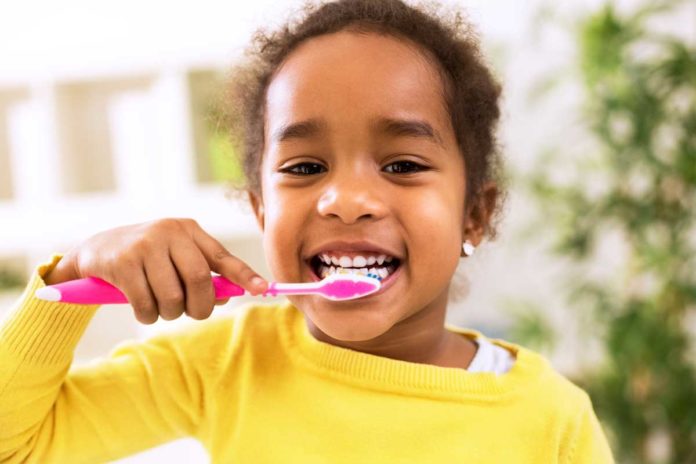Brushing children’s teeth is recommended when the first tooth erupts, as early as 6 months, and the first dental visit should occur no later than age 1 year (2–4). Almost 40 percent of children ages 3 to 6 used more toothpaste than recommended by dental professionals, suggested a new study.
According to the C.D.C. and American Dental Association, parents of children in that age bracket should squeeze no more than a pea-size amount of toothpaste on their brush.
The study involved almost 1,700 children in that age range found that about 38 percent of them used more than the recommended amount of toothpaste. This exceeding amount of toothpaste could potentially exceed the daily recommendation of fluoride intake and also contribute to dental fluorosis.
Fluorosis only affects children because the damage occurs when teeth are developing under the gums. It does not affect overall dental health, but it can lead to white lines or streaks on the teeth.
C.D.C. said, “Children under 3 should be using even less toothpaste, according to the guidelines. For those children, parents should be squeezing only a tiny smear of fluoride toothpaste — roughly the size of a grain of rice. Young children are more susceptible to fluorosis and less capable of spitting out the toothpaste in the sink, making it more likely they will ingest it.”
Dr. Jonathan Shenkin, an association spokesman said, “The study results were a red flag” that the public does not fully understand the guidelines for toothpaste application.”
“One problem is that parents tend to receive contradictory advice on how much toothpaste children should be using, as well as whether the youngest children should be using fluoride toothpaste at all.”
Dr. Alene Marie D’Alesio, chief of pediatric dentistry at the Children’s Hospital of Pittsburgh, said that problems following brushing guidelines often arise from parents not being present alongside their children when they are brushing.”
“What’s really happening is that parents are following the rules of brushing twice a day, but they might not always be there.”
The earliest that parents should leave their child alone when they brush their teeth is 6, although they might consider sticking around until their child is 8.
The C.D.C. offered a few caveats to the results: Parents were self-reporting information, leaving room for more inaccuracy than if the researchers were observing the brushing directly. Additionally, participants were not asked to specify whether the toothpaste had fluoride.
Dr. Shenkin said the message that parents should take away is not that they should stop using fluoride toothpaste. Instead, he advised, “Use it, but use it in the proper quantity so your children don’t swallow too much.”
The study is published in the Centers for Disease Control and Prevention.
